SBBT
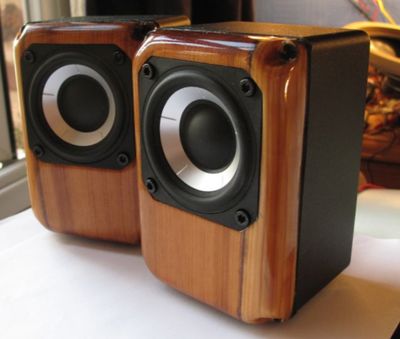
For a while I had been discussing a solution for bringing decent fidelity to a family members home. This actually went so far as to me designing and building a USB DAC/headphone amplifier, sadly this didn't actually work with her laptop, major bummer, so that idea was shelved and my brother got the headphone amp. A little while later she ended up with a tablet computer and microchip released their RN52 bluetooth audio module.
Curious I built a tiny pair of bluetooth speakers based around the BF45 from Visaton, the RN52 module and a TPA3118 class D amplifier from TI. These used a simple passive line level crossover between the RN52 and amplifier to correct for bafflestep losses and to protect the tiny driver from overload via a high pass filter. They sounded fairly decent but the battery life wasnt spectacular. They ran from two 18650, 2600mAh, lithium ion batteries but as no micro controlled was involved, plus only having very basic power management, ran at a fairly high quiescent current. They were however very simple and proved the point that the basic idea was a good one. I used these with my tablet when watching shows on Netflix and Youtube but for a proper room filling sound needed a little more.
First and foremost they needed a more capable driver. Within its own limitations the BF45 sounds very nice but can't really fill a room with music, perhaps a small corner, but definitely not a room. They are excellent for an inexpensive pair of small nearfield speakers, but if you want a little more you need to look elsewhere.
The second issue was with the RN52/amplifier interface and the DAC quality of the RN52. For any real improvement to be had a new DAC would be required and one with an integrated DSP. This would require a micro controller and would bring about the potential for further improvements in power management.
At the time there were no real offerings from semi conductor manufacturers that were compelling for the second issue and none that really impressed me for the first. TI had their TAS5706B chip, which while attractive, wasn't really suitable. It required more voltage than two series Li-ion batteries provided and took up a bit too much space to make it feasible. Tang Band speakers had a few small drive units that would fit into the proposed cabinet but had lacklustre specs for unsupported operation, 0.5mm of xmax really isn't my thing.
Whizz forwards a few months and all of this changed. SB Acoustics added a new full range driver to their portfolio and TI added a preview for a new integrated amplifier. The two items in question were the SB65WBAC25-4 and the TAS5756M.
The latters output stage appeared to have had been built around the TPA3118 allowing it to run from two series Li-ion batteries and also included an onboard DAC/DSP solution that looked very similar to the PCM5142. Indeed the devices programmable registers seemed pretty much identical to those of the 5142 and even with the very poor datasheet I took a chance and assumed my code for the 5142 would work with the 5756M. I am glad I did as this paid off.
SB Acoustics have only been on the scene for a short amount of time, but what they lack in longevity they make up for in engineering ability, having been founded by veterans from the now defunct Danish Sound Technology. Almost all of their drivers measure like champs and are very highly regarded, both in terms of performance and for their relatively high performance to price ratio. The SB65WBAC fit my requirements perfectly. Given SBs datasheet a nice extended response with a stiff aluminium cone that promised pistonic operation across all of the audible band. It also came with what every other driver lacked, a healthy amount of xmax and venting in all of the right places.
From preview to purchaseable took quite a while for both of these products, I waited months for both to become available but neither disappointed.
Curious I built a tiny pair of bluetooth speakers based around the BF45 from Visaton, the RN52 module and a TPA3118 class D amplifier from TI. These used a simple passive line level crossover between the RN52 and amplifier to correct for bafflestep losses and to protect the tiny driver from overload via a high pass filter. They sounded fairly decent but the battery life wasnt spectacular. They ran from two 18650, 2600mAh, lithium ion batteries but as no micro controlled was involved, plus only having very basic power management, ran at a fairly high quiescent current. They were however very simple and proved the point that the basic idea was a good one. I used these with my tablet when watching shows on Netflix and Youtube but for a proper room filling sound needed a little more.
First and foremost they needed a more capable driver. Within its own limitations the BF45 sounds very nice but can't really fill a room with music, perhaps a small corner, but definitely not a room. They are excellent for an inexpensive pair of small nearfield speakers, but if you want a little more you need to look elsewhere.
The second issue was with the RN52/amplifier interface and the DAC quality of the RN52. For any real improvement to be had a new DAC would be required and one with an integrated DSP. This would require a micro controller and would bring about the potential for further improvements in power management.
At the time there were no real offerings from semi conductor manufacturers that were compelling for the second issue and none that really impressed me for the first. TI had their TAS5706B chip, which while attractive, wasn't really suitable. It required more voltage than two series Li-ion batteries provided and took up a bit too much space to make it feasible. Tang Band speakers had a few small drive units that would fit into the proposed cabinet but had lacklustre specs for unsupported operation, 0.5mm of xmax really isn't my thing.
Whizz forwards a few months and all of this changed. SB Acoustics added a new full range driver to their portfolio and TI added a preview for a new integrated amplifier. The two items in question were the SB65WBAC25-4 and the TAS5756M.
The latters output stage appeared to have had been built around the TPA3118 allowing it to run from two series Li-ion batteries and also included an onboard DAC/DSP solution that looked very similar to the PCM5142. Indeed the devices programmable registers seemed pretty much identical to those of the 5142 and even with the very poor datasheet I took a chance and assumed my code for the 5142 would work with the 5756M. I am glad I did as this paid off.
SB Acoustics have only been on the scene for a short amount of time, but what they lack in longevity they make up for in engineering ability, having been founded by veterans from the now defunct Danish Sound Technology. Almost all of their drivers measure like champs and are very highly regarded, both in terms of performance and for their relatively high performance to price ratio. The SB65WBAC fit my requirements perfectly. Given SBs datasheet a nice extended response with a stiff aluminium cone that promised pistonic operation across all of the audible band. It also came with what every other driver lacked, a healthy amount of xmax and venting in all of the right places.
From preview to purchaseable took quite a while for both of these products, I waited months for both to become available but neither disappointed.


The attention to detail in these tiny drivers is rather impressive, especially considering their price. They measure far better than Scan-speaks similar offering that costs a lot more.
The enclosure for the project was chosen to be an aluminium box from Hammond. Not only would this reduce the build work for the design but it would also work in the designs favour vs trying to make something out of MDF. CJD, over at the HTguide forums, first gave me this idea with a tiny speaker he built and I thought it was too good to ignore. While the aluminium is prone to ringing it is also very stiff and takes minimal volume away from the overall cabinet. This is very important in tiny loudspeakers as the thickness of the construction material, and hence the volume it takes up, always needs to be taken into consideration when coming up with a box design. The aluminium is far thinner than any MDF that I would have otherwised used so it's a perfect choice. The other nice thing about aluminium is its thermal conductivity is very high and while the electronics weren't expected to give off much heat it's certainly a better idea to put them inside an aluminium box than a wooden one.
The enclosure for the project was chosen to be an aluminium box from Hammond. Not only would this reduce the build work for the design but it would also work in the designs favour vs trying to make something out of MDF. CJD, over at the HTguide forums, first gave me this idea with a tiny speaker he built and I thought it was too good to ignore. While the aluminium is prone to ringing it is also very stiff and takes minimal volume away from the overall cabinet. This is very important in tiny loudspeakers as the thickness of the construction material, and hence the volume it takes up, always needs to be taken into consideration when coming up with a box design. The aluminium is far thinner than any MDF that I would have otherwised used so it's a perfect choice. The other nice thing about aluminium is its thermal conductivity is very high and while the electronics weren't expected to give off much heat it's certainly a better idea to put them inside an aluminium box than a wooden one.

As can be seen construction is fairly simple. The original aluminium lid for the box was removed and used as a template for the creation of a replacement made from a piece of yew wood. A piece of self adhesive sealing strip was appied around the edige of the wooden front to provide an air tight seal between the wooden front and the aluminium box. The screws to attach the original lid were reused with the wooden one. Once constructed the driver needed to be measured.
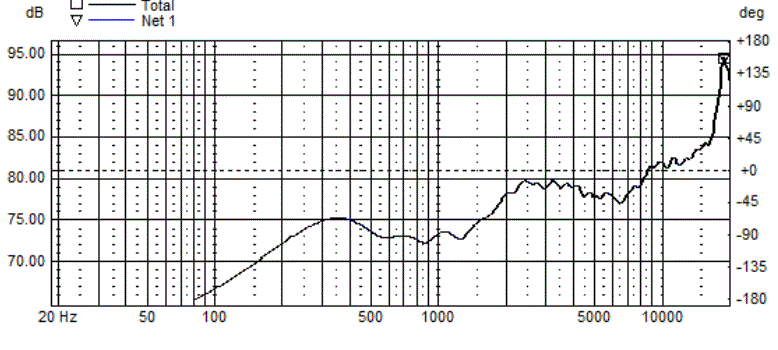
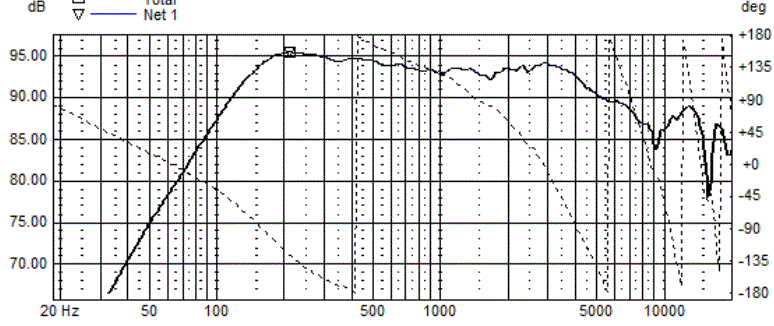
Both nearfield and farfield measurements were taken to fully determine the drivers performance. The nearfield response is fairly predictable, due to the drivers highish Qts and the boxes small volume the end result is a fairly high box f3 and Qtc. This was to be expected and is one of the reasons why the DSP was required for the electronics as it would allow a mild amount of EQ, via a Linkwitz Transform circuit, to give the speakers a more pleasing tonal balance.
The farfield response looks far worse at first glance. The SB65 has an intrinsic rise towards high frequencies and the additional loss towards low frequencies is simply because of baffle step. The SB65 does have a mild depression in the response centred on 1kHz, but this is made worse in my design due to the mild effects of some cabinet diffraction. Thankfully the DSP can help address all of these.
After applying some simple EQ a decently flat frequency response is arrived at.
The farfield response looks far worse at first glance. The SB65 has an intrinsic rise towards high frequencies and the additional loss towards low frequencies is simply because of baffle step. The SB65 does have a mild depression in the response centred on 1kHz, but this is made worse in my design due to the mild effects of some cabinet diffraction. Thankfully the DSP can help address all of these.
After applying some simple EQ a decently flat frequency response is arrived at.
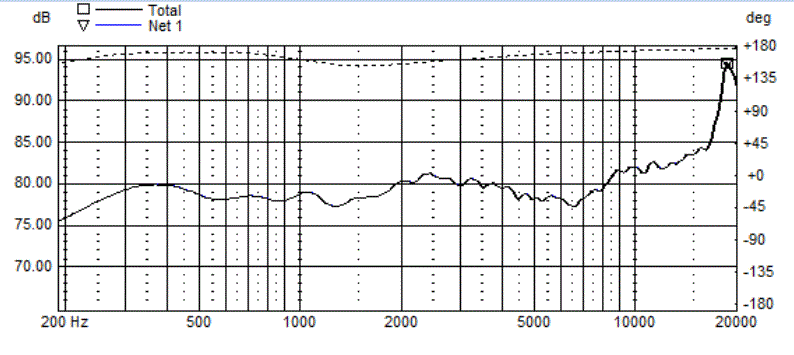
The resultant frequency response is shown above with the EQ curve shown below.

As can be seen very little was done to end up with the above frequency response. Firstly baffle step losses were compensated for, which subjectively flattens out the rise towards high frequecies. Then a mild peaking filter (a reverse notch filter) was used to reduce the dip centred on 1kHz. The rest of the response is due to the Linkwitz Transform circuit. This was used to correct for the highish box f3 and Qtc, bringing the response down by around an octave to give the speakers much more bass. Using an LT is quite a challenge as you have to be very careful not to overload the woofer or clip the amplifier. In this case a high pass was also applied to prevent this from occurring. As can be seen the high pass is quite effective at keeping the gain throughout the bass region and new target box f3 under control.
The rising response wasn't corrected due to how directional larger drivers can become at high frequencies. This way you can adjust how bright the overall sound is by changing the speakers toe-in and the rising response would also prevent the speakers from sounding too dull, in room, when you are moving around.
Power management and the electronics.
The rising response wasn't corrected due to how directional larger drivers can become at high frequencies. This way you can adjust how bright the overall sound is by changing the speakers toe-in and the rising response would also prevent the speakers from sounding too dull, in room, when you are moving around.
Power management and the electronics.

As mentioned before improvements to battery life were a concern with the second iteration and certain steps were taken to solve this issue. By necessity a micro controller was added to allow the TAS5756M to function, but this does allow for many more options when it comes to shutting down various parts of the speakers in order to save power.
In the first design I opted to use a simple linear regulator for providing the 3.3V rail necessary for running the bluetooth module. At the time this was the only chip that required a 3.3V supply so I figured a switching regulator an unnecessary complication but in the second design this is most certainly not the case. Not only does the RN52 require a 3.3V supply but so do the micro controller and the TAS5756M. Roll on the TPS560200 from TI. This is a very simple synchronus buck regulator, chosen to keep efficiency high and it also supports burst mode operation. It requires a minimal number of supporting components and offers an adjustable output rail.
The latter is important, especially in conjunction with the burst mode operaion, for keeping the power losses low when the loudspeaker is doing nothing, such as when accidentally left on. The TAS5756M offers a nice in built feature that results in a lot of the onboard circuitry powering down when one, or more, of the externally provided I2S clocks aren't present. As luck would have it when the RN52 is idling it shuts down all outbound clocks to save power so in doing so also results in the TAS5756M partially shutting down automatically. Then after a certain amount of time idling the RN52 completely shuts down thus leaving the overall current drawn on the 3.3V rail much lower than it is during normal operation.
To provide the 3.3V rail I used very low drop out linear regulators that also have a very low quiescent current. This means that when the various digital parts start shutting down very little power is lost simply to the regulators being powered up. The linear regulators low drop out of a few hundred mV also allows the buck regulator to regulate to within ~0.3V of the actual 3.3V rail, again increasing efficiency with the buck regulators burst mode helping to keep power losses low under light load.
The result is that the speakers can be accidentally left on for weeks without the batteries running out of juice and when in normal operation they will easily provide many hours of continuous use, obviously this is dependent on how loud you listen.
It goes without saying that these sound excellent.
In the first design I opted to use a simple linear regulator for providing the 3.3V rail necessary for running the bluetooth module. At the time this was the only chip that required a 3.3V supply so I figured a switching regulator an unnecessary complication but in the second design this is most certainly not the case. Not only does the RN52 require a 3.3V supply but so do the micro controller and the TAS5756M. Roll on the TPS560200 from TI. This is a very simple synchronus buck regulator, chosen to keep efficiency high and it also supports burst mode operation. It requires a minimal number of supporting components and offers an adjustable output rail.
The latter is important, especially in conjunction with the burst mode operaion, for keeping the power losses low when the loudspeaker is doing nothing, such as when accidentally left on. The TAS5756M offers a nice in built feature that results in a lot of the onboard circuitry powering down when one, or more, of the externally provided I2S clocks aren't present. As luck would have it when the RN52 is idling it shuts down all outbound clocks to save power so in doing so also results in the TAS5756M partially shutting down automatically. Then after a certain amount of time idling the RN52 completely shuts down thus leaving the overall current drawn on the 3.3V rail much lower than it is during normal operation.
To provide the 3.3V rail I used very low drop out linear regulators that also have a very low quiescent current. This means that when the various digital parts start shutting down very little power is lost simply to the regulators being powered up. The linear regulators low drop out of a few hundred mV also allows the buck regulator to regulate to within ~0.3V of the actual 3.3V rail, again increasing efficiency with the buck regulators burst mode helping to keep power losses low under light load.
The result is that the speakers can be accidentally left on for weeks without the batteries running out of juice and when in normal operation they will easily provide many hours of continuous use, obviously this is dependent on how loud you listen.
It goes without saying that these sound excellent.
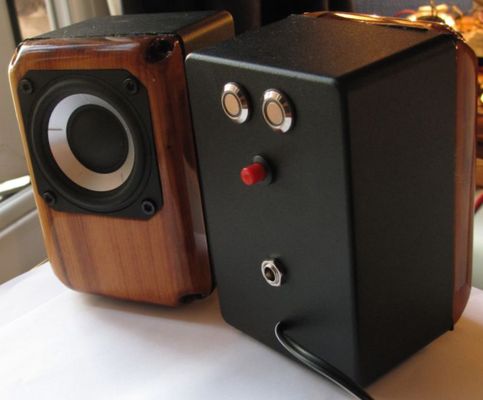
Since beimg built I have also built two more pairs of these for other family members. One pair for an aunt and uncle who listened to the first pair for all of thirty seconds before deciding they'd like a set and a pair for my parents. The pair for my parents were a little bit different in that they exchanged the bluetooth module for an ADC and SPDIF input. They currently use them as a much needed improvement to the speakers built into their TV. The second pair of bluetooth speakers were virtually indentical to the first set except that the battery charging circuit was changed to use the MAX1873. This is a switched mode charger that would allow the use of far higher charging voltages vs the linear charger used in the first pair. I figured this would be useful as the users use a campervan regularly and being able to charge the speakers from the ~14 volts that cars can provide would add to their ability to be used on the road.